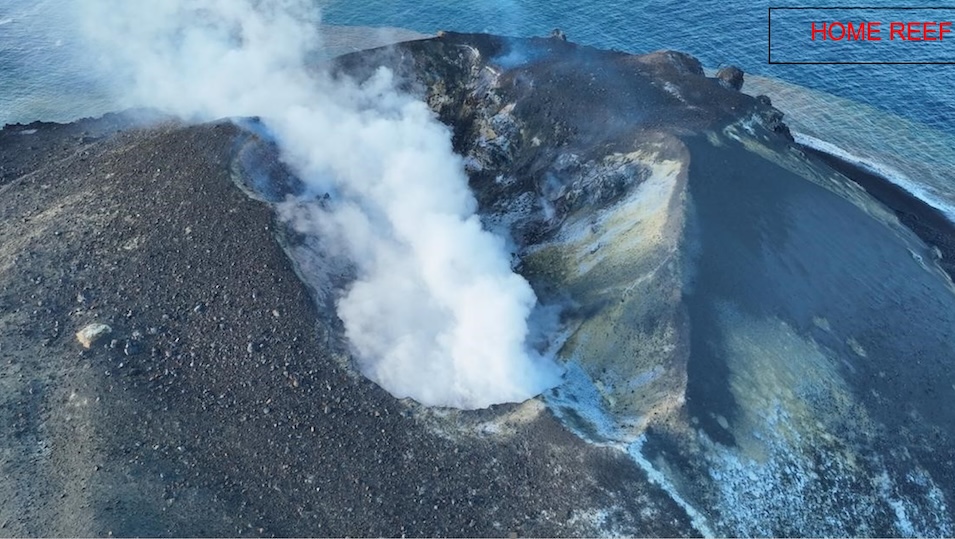
A joint scientific voyage visited three sea volcanoes, Hunga-Tonga Hunga-Ha’apai (HTHH), Tofua Volcano and Home Reef Volcano to assess their current activity status from 5-6 November 2025. This mission was supported by the University of Otago and the University of Auckland (New Zealand) and Tonga's Ministry of Lands, Survey, Planning and Natural Resources.
CEO Mr. Taaniela Kula said yesterday that it is important for Tongans to remain vigilant about the threats of volcanic activity in the Kingdom.
Home Reef has remained in an active eruptive state for nearly one year and is being actively monitored by the Ministry through satellite imagery. The research mission travelled with the Tongan navy on HMAF Ngahau Koula, captained by Kilioni Mafi to make its first on site research observations at the location.
Home Reef

“At Home Reef, the team observed the volcanic island that has been constructed is over 1 km in diameter and consists of a solid base of lava flows, with a cone on top. The new island is around 70 m high and has an actively venting crater emitting steam and SO2 gas,” MLSP&NR reported.
The team flew a drone over the island to collect the first ever detailed topographic survey data, taking video and photographic footage to construct a detailed new 3-D model of the island, in collaboration with Prof. Jim Garvin from NASA in the USA.
“The gas measurements at this volcano, the first ever made, indicate release of ~100 tonne SO2/day. This shows that magma is close to the surface and that the eruption is not yet over. The island shows evidence of recent eruptions that produced both ash falls and lava flows. With the vent now above water on a stable island, future eruptions may produce more ash. The sides of Home Reef island show some signs of small landslides that could produce local tsunami,” the mission reported.
“There was very high levels of gas release in different parts of the island as well as the main crater, leading to a high level of alteration of the volcanic rock and also blooms of algae in the seawater around the volcano.”
Professor Cronin suggested that the island is likely to survive a few years, because of the strong lava base and that since the vent is now above sea-level, future eruptions of ash and or lava flows should be expected if the activity continues at the same level of magnitude of past eruptions. However, the scale of eruptions so far during this eruption episode are relatively small. If this rate of activity remains, ash fall and tsunami hazard are likely to be restricted only to within 10 km of Home Reef.
The Ministry of Lands, Survey, Planning and Natural Resources, will continue close monitoring of the volcano continues every day, via satellite monitoring of heat flow and SO2 gas output, with also visual satellite and radar satellite observations used to evaluate major changes to the island and collaboration with scientific partners to ensure timely information and public safety.
“This field visit provides the first important ground-truthing for these satellite observations and with the high-precision 3-D model to be constructed from the mission data, there will be greater accuracy of ongoing forecasts of the volcanic activity,” they said.
The investigation team on the first mission to view Home Reef’s current activity included Professor Shane Cronin, Dr Barbara Martelli (University of Auckland), Dr Jie Wu (University of Auckland and University of Otago), with Mr Rennie Vaiomounga and Mr Valeliano Tovi from the Tonga Geological services.
Hunga Tonga Hunga Ha’apai (HTHH)
The team first reached Hunga Tonga Hunga Ha’apai (HTHH) volcano which was showing no signs of visible activity, where the remnant islands from the 2022 eruption are gradually being eroded by wave action.
Tofua Volcano
The next stop was Tofua volcano, with the team carrying out traverses to measure the output of sulphur dioxide (SO2), one of the main gases used to trace volcanic activity. The measurements showed continued gas emission at more than 250 tonnes of SO2/day. They said this represents a decrease from approximately 700 tonnes SO2/day recorded in October 2022. This shows that the volcano is in a normal state of activity.



